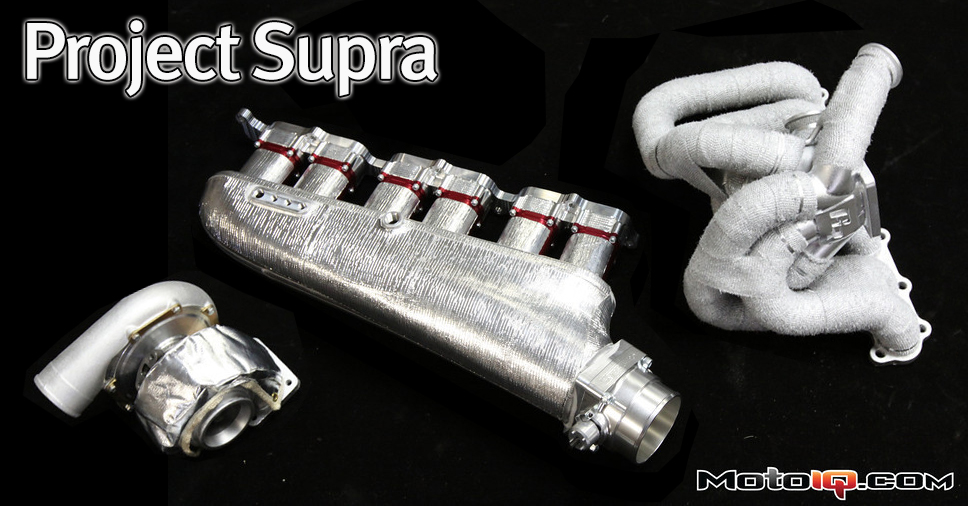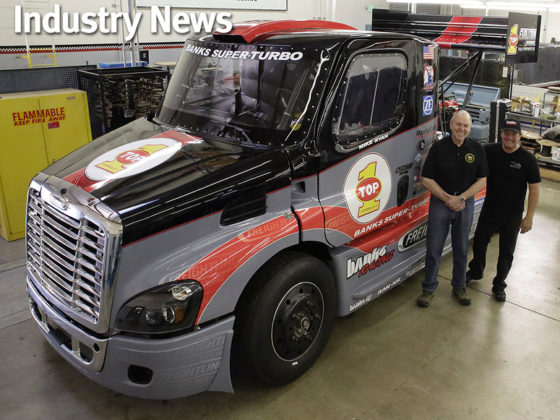 |
Project Supra, Part 5: Thermal Coating, Wrapping, and Engine assembly.
Keeping Cool Under Pressure
by Pablo Mazlumian
A notable tradeoff to turbocharged power is the potential for more heat in the engine bay, leading to less-than-optimal power and increased turbo lag. Find out how we minimize these fun-killers. Our cylinder head and built short block also come together, and we show off the variety of MKC-tuned boosted cars.
In Part 4 we shared our beefy turbo components, which included a decent-sized 67-mm Precision turbo with larger 1.15 divided housing, PowerHouse Racing's large-runner S45 exhaust manifold and Hypertune's big boy intake manifold. With our 1-mm oversized, and ported and polished cylinder head, as well as the exhaust setup we'll be showcasing soon, the engine should flow copious amounts of air. But this comes at a price, and the cost could be a significantly lazier turbo spool.
To combat the aforementioned lag, we've ordered our turbo in dual ball bearing form, hoping it will spool up quicker than its journal-bearing brother. We also used lightweight engine components in both the cylinder head and block from Part 1 to help with overall engine response.
There is something else to consider, however. With more power—especially from a turbocharged engine—comes more heat. And more radiant heat from a turbocharger, manifold, downpipe and block not only hinders overall engine response—affecting torque—but also top-end power, due to the oxygen-scattered environment. A known rule of thumb is roughly an “11F increase in intake air temperature equals a 1% decrease in horsepower.” With our application, this can be significant if not taken care of.
Containted heat is a good thing, since a turbo relies on heat to spin the hot-side turbine. So, if we can contain more heat inside the exhaust manifold and turbine housing, we're rockin'. Our objective today is to help reduce underhood temperatures as well as maintaining the heat inside the turbo components, and away from the intake stuff. We do this with Swain Tech coatings and Cool-it products from Thermotec.
 |
| Our PowerHouse Racing S45 exhaust manifold and Precision 6766 exhaust housing spent a couple of weeks at Swain Tech for its White Lightning thermal coating treatment. |
 |
| Swain's White Lightning coating goes on .015-in thick—reportedly about 5 times thicker than the industry norm–and very evenly . With the larger 1.5-mm S45 primaries on this PHR manifold we get more flow but at the cost of more lag. The insulated heat should help keep exhaust velocity higher and counter this drawback with a little better turbo response. |
Whether turbocharged or normally aspirated, there are significant engine benefits with a Swain Tech coated manifold or header. In turbocharged engines, it helps spool the turbo. In a normally aspirated engine, the sustained velocity through the header improves exhaust scavenging, which also can increase power.
The other way power is optimized in both applications is reducing the under-hood temperature. Swain reports a coated exhaust header radiates between 35-55% less heat in the engine bay. Obviously, many other parts in the engine radiate heat as well, so this claimed percentage range probably wouldn't be proportional to the drop in intake-air temp. But even if it were half of the minimum 35%, we're talking a near-2% improvement, potentially, as well as extended life for nearly every rubber and plastic component under the hood.
 |
| Our 1.15 divided Precision turbo housing got the Swain treatment as well to insulate the heat all the way through the turbine, helping turbo response. |
 |
| Cool It is a product line created by Thermotec, that offers a plethora of heat wraps, shields and sleeves to maximize performance and prolong the life of rubber hoses. We chose their header wrap (in 50ft rolls) with Hi Heat coating spray, T4 turbo cover, Cool Tube shielding for intercooler piping, some adhesive shielding, and heat sleeves for various hoses. |



